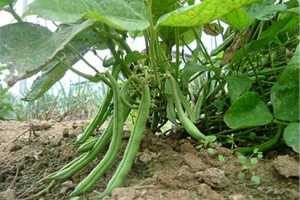How to Grow French Beans – A Guide to Growing French Beans
 French Beans
French Beans
There are dwarf and climbing varieties of French beans. You can grow them either to eat fresh, or to be dried and stored (often called haricot varieties). They are all members of the legume family.
Climbing French beans are grown in the same way as Runner Beans, so this page concentrates on the dwarf varieties. These are easy to grow, and because they can be spaced closely, are very suitable for being grown in containers.
Sowing and Growing French Beans
- Add extra organic matter or humus to the soil before planting
- French beans are not frost hardy. Very early sowings can be made in pots under cover, planting out after the risk of frost has passed.
- Alternatively, sow direct but if making an early sowing in March – early April, use a cloche to warm the soil up first and keep it in place for protection after sowing.
- Better results come from sowing in May, remembering to protect against any late frosts.
- Sow 5 cm (2”) deep, at 10 cm (4”) spacing, in rows 45 cm (18”) apart.
- Successional sowing until June or July means cropping into October and until the first frosts.
- Water well in dry weather during and after flowering.
- Feed with a high potash feed (e.g. liquid tomato fertiliser).
Harvesting, Eating & Storing French Beans
- Approximate time from sowing to harvesting is 8-12 weeks, therefore first crops are likely to be picked in July.
- Pick the pods when they reach 10-15 cm long. Take care not to pull too hard and loosen the plant.
- Pick fresh beans several times per week to prevent pods ripening and to encourage more pods to be produced.
- Purple varieties turn dark green upon cooking.
- All varieties freeze well, except for yellow varieties.
- Haricot (dried) beans do not need to be picked as regularly; leave them on the plant to swell and start to dry off. Then remove them and dry indoors (or dig up the whole plant and hang it upside down to dry). Remove the beans from the pods when the pods start to split. Dry them for a while longer on a rack or piece of paper.
- If the beans are not completely dry e.g. if the summer has been wet, they will turn mouldy in storage. Freeze them instead if this is the case.
Pests and Problems with French Beans
- Slugs will attack young plants and sometimes the young pods
- Blackfly may build up as the plants grow
- Protect from frost as the plants are not hardy
Varieties of French Beans
- Most varieties have green pods, but there are also purple and yellow varieties
- Some varieties are flat-podded, whereas others are round and pencil-shaped
- The ‘Teepee’ varieties hold the pods above the foliage, making for easier picking
- Popular green pencil varieties include Blue Lake, Tendergreen, Delinel (AGM) and Masterpiece
- Purple Teepee or Purple Queen are popular purple varieties
- The most commonly-found dried bean is Borlotto (this is also available as a climbing variety)
- Calzone is particularly compact



